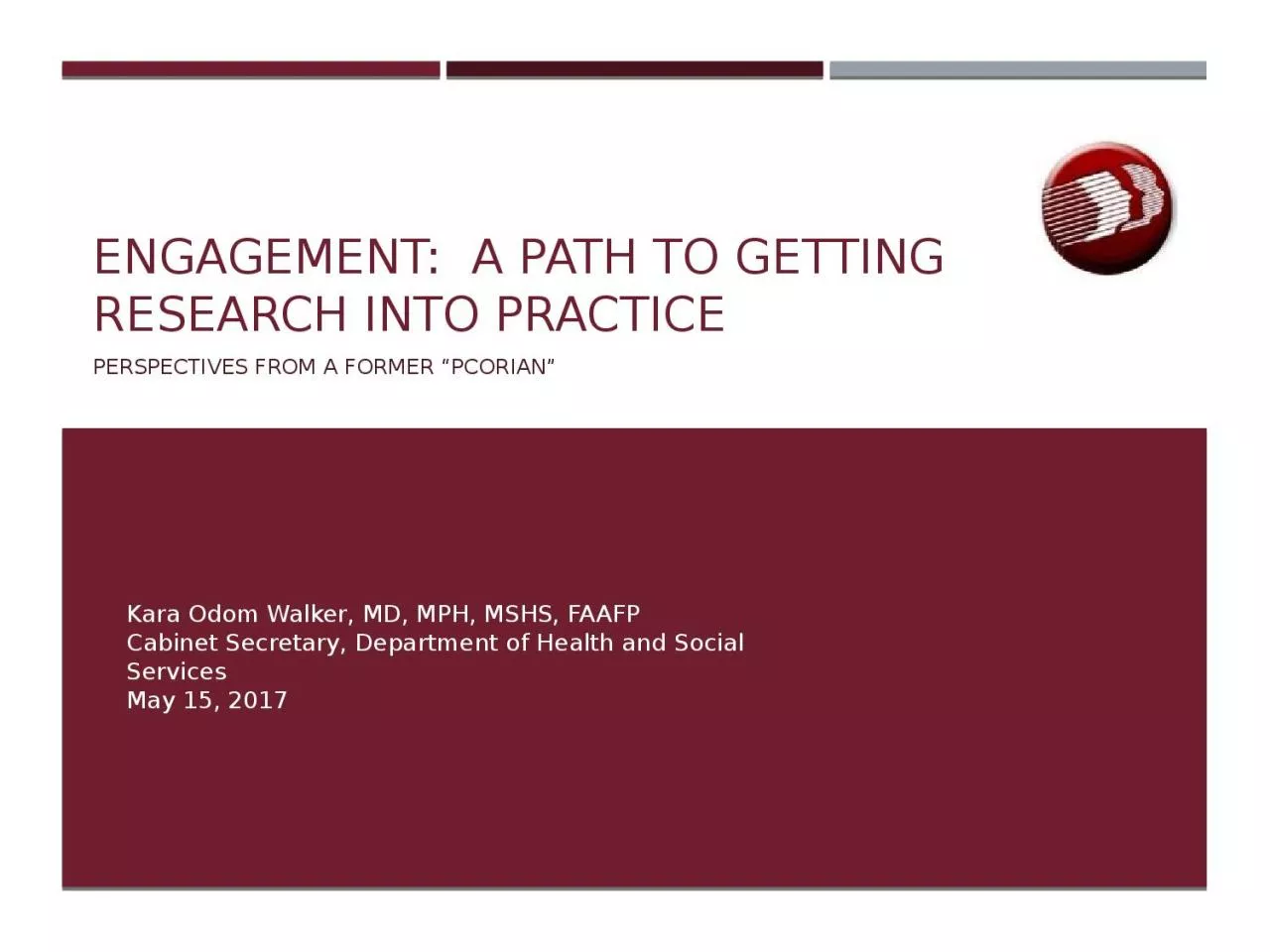

Research into practice Perspectives from a Former PCORIAN Kara Odom Walker MD MPH MSHS FAAFP Cabinet Secretary Department of Health and Social Services May 15 2017 An independent research institute authorized by Congress in 2010 and governed by a 21member Board of Governors represe ID: 927258
Download Presentation The PPT/PDF document "Engagement: A Path to Getting" is the property of its rightful owner. Permission is granted to download and print the materials on this web site for personal, non-commercial use only, and to display it on your personal computer provided you do not modify the materials and that you retain all copyright notices contained in the materials. By downloading content from our website, you accept the terms of this agreement.
Slide1
Engagement: A Path to Getting Research into practice
Perspectives from a Former “PCORIAN”
Kara Odom Walker, MD, MPH, MSHS, FAAFP
Cabinet Secretary, Department of Health and Social Services
May 15, 2017
Slide2Slide3An independent research institute authorized by Congress in 2010 and governed by a 21-member Board of Governors representing the entire health care community
Funds comparative clinical effectiveness research (CER) that engages patients and other stakeholders throughout the research process
Seeks answers to real-world questions about what works best for patients based on their circumstances and concerns
About PCORI
3
Slide4“The purpose of the Institute is to
assist patients, clinicians, purchasers, and policy-makers in making informed health decisions
by advancing the quality and relevance of evidence concerning the manner in which diseases, disorders, and other health conditions can
effectively and appropriately be prevented, diagnosed, treated, monitored, and managed
through research and evidence synthesis...
--from PCORI’s authorizing legislation
… and the dissemination of research findings with respect to the relative health outcomes, clinical effectiveness, and appropriateness of the medical treatments, services...”
PCORI’s Broad and Complex mandate
4
Slide52009 estimate: As much as 85
% of research funding is avoidably wasted
Increasing Value and Reducing Waste
Avoidable waste in the production and reporting of research evidence.
Chalmers I,
Glasziou
, P. Lancet 2009; 374: 86-89.Increasing value and reducing waste in biomedical research: who's listening? Moher D, et al. Lancet 2015; Online: Sept.28Stages in research production that lead to waste. Moher et al.
Slide6Engagement as a Path to Useful, High-Quality Research
Evaluation
Proposal Review; Design and Conduct of Research
Topic Selection and Research Prioritization
Dissemination and Implementation of Results
Slide7Does Engagement Make a Difference?
A
systematic
review* provides the first international evidence of the impact of patient and public involvement on research on health and social-care research.
*
Health Expectations 2014;
17(5): 637–650. Literature search from 1995-2009 identified 66 studiesAnalysis showed patient and public involvement enhanced quality and appropriateness of researchImpacts were described for all stages of researchBut authors note the evidence base on impact of engagement still needs significant enhancement
Slide8Patient-Centeredness
8
Slide9What is comparative effectiveness?
9
Slide10Why we need CER
10
“ . . . for want of appropriate studies, innumerable practical decisions facing patients and doctors every day do not rest on a solid foundation of knowledge about what constitutes the best choice of care.”
Institute of Medicine Report June 2009
Slide1111
Evidence of evidence gaps
JAMA. 2009;301(8):831-841
Among 16 current guidelines reporting levels of evidence including 2,711 recommendations:
Level of evidence A – 11%
Level of evidence C – 48%
Slide12“Variation in surgical rates is high and represents both gaps in outcomes research and poor patient decision quality.”
A Dartmouth Atlas of Health Care Series
http://www.dartmouthatlas.org/downloads/reports/Cerebral_aneurysm_report_09_30_14.pdf
More evidence: variability in practice
12
Slide13Research that . . .
Compares
benefits and harms
of at least two different
existing
methods to prevent, diagnose, treat, or monitor a clinical condition or to improve care delivery
Is performed in
real-world
populations
Informs a specific clinical or policy
decision
(“decisional dilemma”)
Adapted from
Initial National Priorities for Comparative Effectiveness Research
, Institute of Medicine of the National Academies
Comparative Effectiveness Research
13
Slide14Patient-centered outcomes research, or PCOR, is a relatively new form of comparative effectiveness research
Considers patients’ needs and preferences while focusing on the outcomes most important to them
Investigates what works, for whom, under what circumstances
Helps patients and other health care stakeholders make better-informed decisions about health and health care options
Patient-centered outcomes research
14
Slide15JAMA 2002; 288; 2981-97.
Comparative effectiveness - ALLHAT
A total of 33,357 participants aged 55 years or older with hypertension and at least
1 other
CHD risk factor
Participants were randomly assigned to receive
chlorthalidone, 12.5 to 25 mg/d (n = 15,255); amlodipine, 2.5 to 10 mg/d (n = 9,048); or lisinopril, 10 to 40 mg/d (n = 9,054) for planned follow-up of approximately 4 to 8 years.Key question: What is the optimal first line therapy for hypertension?15
Slide1616
Key conclusion:
Thiazide-type diuretics are superior in preventing 1 or more major forms of CVD and are less expensive.
They should be preferred for first-step antihypertensive therapy.
Over a patient’s lifetime,
chlorthalidone
was always least expensive (mean $4,802 less than amlodipine, $3,700 less than lisinopril)Adding quality of life did not change these results
Slide17JAMA 2002; 288; 2981-97.
Comparative Effectiveness- ALLHAT
How do the results of ALLHAT help patients and clinicians make decisions?
Provides information on harms and benefits of three major
antihypertensives
.
chlorthalidoneamlodipinelisinoprilLarge enough to allow subgroups to be examined.Age <65 vs. >65Men vs. womenBlack vs. nonblackDiabetes vs. no diabetes17
Slide18Comparative effectiveness
18
Slide19Rising numbers of Citations for “patient-centered outcomes research” in PubMed (n=290)
19
Extending patient-centered outcomes to all research
Extend engagement to policy and social determinants of health
Slide20Improving the flow and relevance of research evidence for implementation
R
Lobb
, GA Colditz. Implementation science and its application to population health.
Annu
Rev Public Health
. 2013;34:235–251
Slide21FUNDERS Role in a National Health Research Program
21
DISCOVERY
COMPARATIVE
CLINICAL
EFFECTIVENESS
RESEARCH
REGULATION/
APPROVAL
NIH
Industry
Academia
FDA
CMS
Patients
Specialties
Payers
CLINICAL &
HEALTH CARE
POLICY
PCORI
YOU ARE HERE
Slide22Slide23QUESTIONS? COMMENTS?